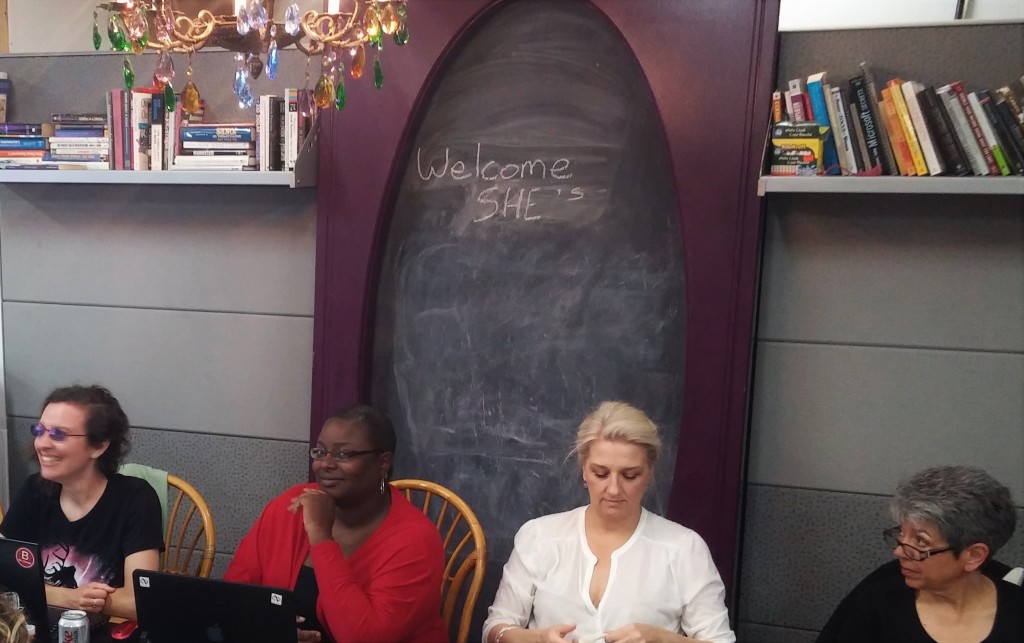
In my line of work as a program consultant, I am often hired to help startup incubators and innovation spaces attract and, more importantly, retain more women entrepreneurs; in Canada their public funding support is increasingly dependent on doing so. Turns out, marketing only to women — tossing in a few pink bean-bag chairs, and offering free tampons and perfumes in newly labelled gender-neutral washrooms — doesn’t cut it. Neither does creating women-only startup programs embedded in co-ed spaces with programs that reinforce the patriarchal status quo. They sound good at first, but soon after the program starts, women entrepreneurs end up feeling ghettoized and stigmatized. They end up frustrated. They leave. And they don’t come back.
Today, only 16% of incorporated enterprises in Canada are women-led and women majority owned. Reports say female founder participation in mainstream co-ed incubator spaces hovers at 5%-30% despite the fact that the number of female entrepreneurs is increasing (GEM Canada reports a 70% increase in interest in entrepreneurship from 2014 to 2017). Further studies have shown that women-majority owned businesses out-perform their male counterparts on several metrics.
Somehow we still haven’t cracked the code. Ineffective acceleration programs for female founders costs Canada alone billions of dollars of lost economic opportunity–not to mention the waste that comes resource misfires. What economy can afford that?
Many people leading co-ed entrepreneurship and innovation incubators acknowledge the issue. They are also familiar with the mountain of research out there which confirms, again and again, that women face additional barriers as entrepreneurs thanks to gender-bias in our financial systems and a sexist economy that privileges those who can delegate caregiving and don’t need time off after physically growing and finally squeezing a an eight pound plus new human out of their diet riddled bodies – not to mention feeding that hungry little human via your boobs for months after. In fact, people running incubators witness examples of the many barriers women face first hand. They have VIP seats in the stadium when it comes to observing how women experience and must navigate entrepreneurship differently to succeed. They also see how women of colour, Indigenous women, queer women, immigrant women, and low-income women experience additional challenges, some making ends by going to food banks.
So why are these VIP innovation and entrepreneurship process and skills experts having so much trouble figuring out how to help women founders, and their enterprises, flourish?
The Sisterhood Strikes Back
Some say “who cares”! If the system isn’t serving women, we do what they we always done—roll up our sleeves and start building alternative ones of our own.
That’s why privately run, often community-based, intersectionally-minded, women-led incubators, accelerators, funds and even online programs are springing up everywhere. In addition to providing first-class support, they also create safe, culturally relevant and often child-friendly spaces; offer programming outside of peak caregiving times; plus validate alternative business models and gendered innovations.
Sadly, unlike mainstream co-ed spaces, few if any receive government subsidies or corporate financial support. Thus, they are tasked with trying to create economic impact on shoestring budgets. To sustain their operations, they need to charge for the services that mainstream co-ed incubators can offer for free or at subsidized rates (leaving women with less to invest in their own company). In the US, women-only spaces are also being challenged by men’s rights activists.
What co-ed incubators must do to truly unleash the potential of women entrepreneurs
While sitting in one of these “women-friendly” co-ed programs last fall, I noticed the incredulous looks on women’s faces when the presenter started talking about how to conduct a pitch to venture capitalists and how to “dress for success” at such meetings. Incredibly, his advice was geared entirely to men—all the pictures in his presentation were men and his dress for success advice included images of fashionable suits, ties, and polished wing-tipped shoes. After noticing that half the audience was female, he joked that women didn’t need advice on how to dress because “Girls already know how to look good.”
Organizers cringed. The penny dropped.
If incubator leaders want to succeed in advancing women-led startups, they have to start by gutting and re-building, from scratch. The three most important parts of any incubator program: The roster, the ecosystem and the program.
Here are just a few practical ideas.
When recruiting mentors, instructors, or entrepreneurs in residence, make an effort to weed out the “I don’t care about gender—as long as the business is good” meritocracy types. Try to steer clear of those who clearly don’t understand how systems of oppression intersect to shape experiences, opportunities, and choices. Attempts at credibility–even if their expertise is useful- by these folks are going to fall flat.
Require mentors and staff to complete a gender-based analysis (available online for free) or, better yet, offer a “Feminist Perspectives on Gender and the Economy 101” session. Or have them sign up to Jennifer Armburst’s online Feminist Business School, recently written about in Forbes magazine, to explore just one feminist’s approach to entrepreneurship-there are many. Challenge mentors, entrepreneurs in residence, and experts to interrogate their own beliefs before perpetuating regressive strategies when coaching others. Help them update their presentations as well as their mindset by exposing them to deeper knowledge about broken systems they unwittingly perpetuate by refusing to get woke.
Diversify mentor stock. It’s not enough to have a reasonable proportion of men and women; it’s critical to include people with experience building successful companies in alternative ways. Like Laura Jean Berhardson, for example, founder of the Fresh Collective (Based in Toronto), who can talk to budding entrepreneurs about how to create and run a successful, non-biased, community-focused collective.
Set a strategic goal to develop a gender-enlightened ecosystem of support specifically for women entrepreneurs, which includes reaching out to and engaging diverse women-centered business networks such as the Canadian Women’s Chamber of Commerce, Women’s Enterprise Centres), Immigrant Women in Business, How She Hustles, as well as feminist organizations in your community and women’s studies faculties.
And finally. Seriously overhaul the increasingly irrelevant Silicon Valley inspired curriculum. The economy is shifting at a macro level-again. Yet, for the most part, incubator programs tell people that the real way to start and grow a successful company is to run down your environmentally-poisoned immune system, take up parkour as a stress reliever, and alienate your friends and family while working 24-7. That’s how Silicon Valley works, right? Oh, don’t forget to throw in patriarchal aspiration of building a sustainable, profitable or exit-ready company from scratch in less than 18 months. In these environments, entrepreneurial success depends on mastering that master hype and, often, getting on board with toxic masculinity.
Not surprisingly, women entrepreneurs and, increasingly, people of all genders aren’t buying in.
Retaining and effectively supporting women and social-change minded entrepreneurs of all genders means sourcing proven feminine approaches to venture creation and growth — practices that have been developed by feminist thought leaders such as Marjorie Kelly on the generative economy, CV Harquail and Lex Schroeder for the feminist business model canvas, and Saras Srasvathy on effectual reasoning. Barbara Orser and Catherine Elliot’s book Feminine Capital and accompanying toolkit should be required reading for entrepreneurs of all genders along with Emergent Strategy by Adrienne Maree Brown. Feminist Theory: From Margin to Centre by bell hooks is an ultimate program-design handbook. Incubators would also do well by emulating Babson College’s curriculum at it’s Centre for Women’s Entrepreneurial Leadership; it actually includes seminars on the history of women in the economy in its program for aspiring women entrepreneurs.
Presently, there are more than 47 mainstream incubator programs operating in the province of Ontario (Over 8000 across the globe; less than 10% are women-centered in the U.S.) and not one of them touches on feminist business practice as an opportunity to develop alternative ways of designing, funding, and operating successful ventures.
“Pink” marketing and recruitment tactics may very well get more women in the door. But retaining their talent in the startup and innovation ecosystem means acknowledging and respecting there are many ways to start and grow a successful enterprise. This includes celebrating the power of feminine values, effectively supporting alternative approaches to venture creation, and rethinking patriarchal practises.
Given the poor rate of participation of women in these spaces, it’s time incubator leaders take these ideas seriously. This is an urgent issue.
Stop renovating. Hit the demolition button. And rebuild from scratch. With new tools.
Related Reading:
THE FUTURE OF ACCELERATORS AND INCUBATORS by PK Mutch
WHY WE NEED DIVERSE APPROACHES TO STARTUP INCUBATION (HINT: ONE SIZE DOES NOT FIT ALL) by Priya Ramanujam
OFF THE RADAR: Women-Led and Feminist Entrepreneur Support Organizations in Canada

Subscribe today! (We’re on Patreon too!)










